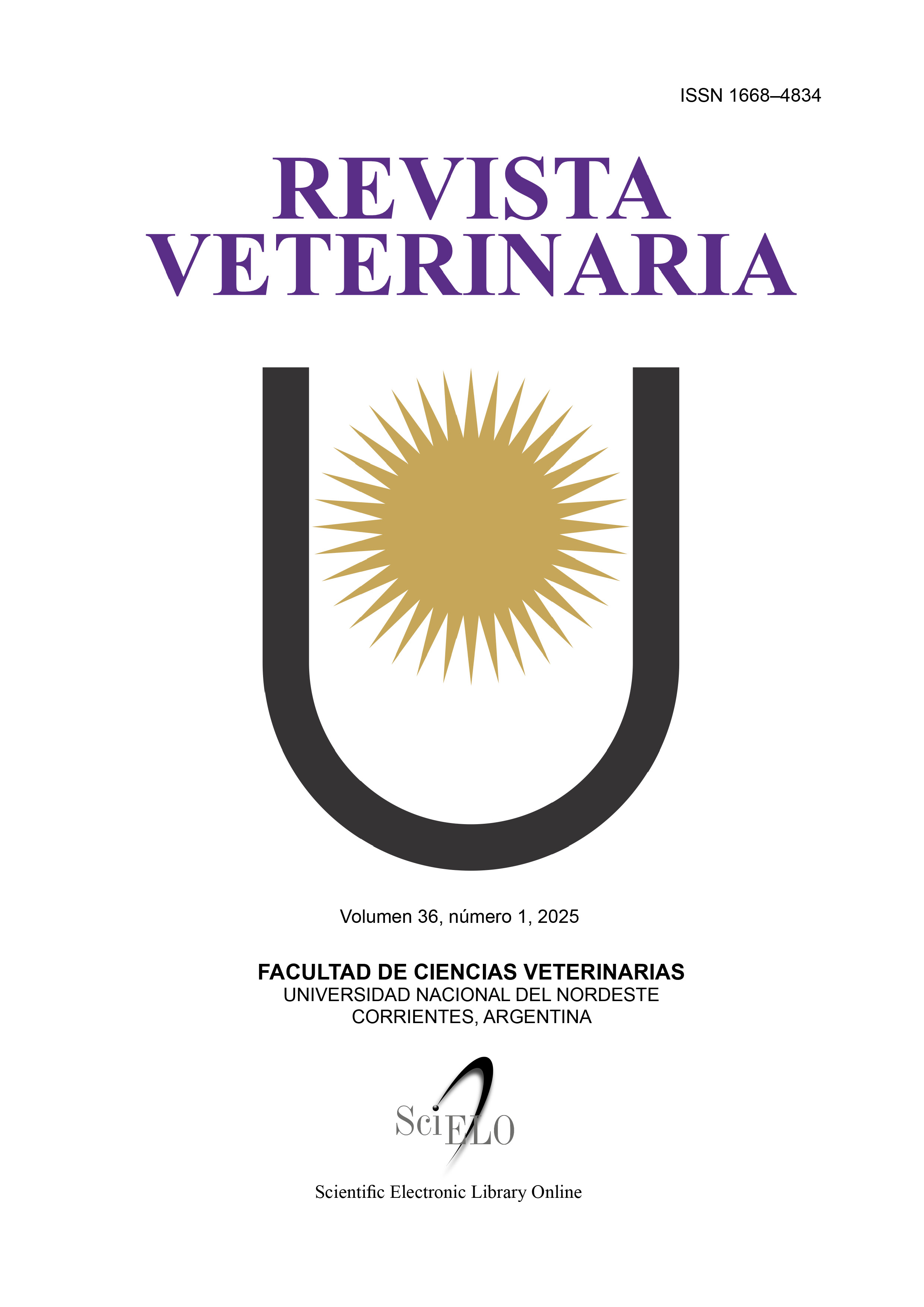Variabilidad de la interacción parásito-hospedador de diferentes genotipos Mus musculus al desafío experimental con Trichinella spiralis
DOI:
https://doi.org/10.30972/vet.3628324Palabras clave:
Trichinella spiralis, ratones, selección, peso, variabilidad genética, susceptibilidadResumen
La interacción parásito-hospedador es una relación compleja que determina el resultado de una infección. Trichinella spiralis es un nematodo que afecta a una amplia gama de animales, los que pueden transmitir la infección al humano. El estudio de la interacción con su hospedador es fundamental para obtener estrategias que permitan reducir esta parasitosis. El objetivo de esta investigación fue evaluar las potenciales diferencias en la interacción parásito-hospedador frente al desafío con Trichinella spiralis por parte de diferentes genotipos de hospedadores, conformados por cuatro líneas de ratones seleccionadas por peso y una línea testigo derivadas de la cepa CF1 (s, h, s´, h´ y t, respectivamente). Fueron infectados ratones macho de las líneas con una dosis de 400 larvas musculares. El índice de expulsión, a los 15 días posinfección, demostró que la línea t fue la más eficiente, mientras que la línea h fue la más ineficiente en este proceso, al presentar el mayor número de gusanos adultos en el intestino. En la etapa crónica de la infección, el número de larvas musculares enquistadas (carga parasitaria relativa) fue significativamente mayor en la línea liviana h, y menor en t y h´, mostrando diferencias en la interacción entre las líneas. La evaluación de los cambios histopatológicos del duodeno también mostró diferencias entre las líneas estudiadas. Esta variabilidad hallada sería producto del proceso sistemático de selección artificial fenotípica por peso corporal a los que se suman los efectos dispersivos -efecto fundador y deriva génica- asociados al bajo tamaño efectivo de las poblaciones.
Descargas
Citas
AVMA. Guidelines on Euthanasia of Animals: 2020 Edition. Disponible en: https://www.avma.org/sites/default/files/2020-02/Guidelines-on-Euthanasia-2020.pdf. Último acceso: enero 2025.
Bell RG. The generation and expression of immunity to Trichinella spiralis in laboratory rodents. Adv Parasitol. 1998; 41: 149-217.
Bell RG, Liu WM. Trichinella spiralis: quantitative relationship between intestinal worm burden, worm rejection, and measurement of intestinal immunity in inbred mice. Exp Parasitol. 1988; 66: 44-56.
Bernardi S, Brogliatti G, Oyarzabal MI. Diferencias de fertilidad en ratones seleccionados por peso. Analecta Veterinaria. 1999; 19(1/2): 11-7.
Bernardi S, Brogliatti G, Oyarzabal MI. Ovarian Structure in Mice Lines Selected for Weight. Anat Histol Embryol. 2009; 38: 200-3.
Bernardi S, Brogliatti G, Oyarzabal MI. Efectos de la Selección y de la Superovulación en las Pérdidas Gestacionales de Ratonas CF1. Int. J. Morphol. 2011; 29(1): 204-13.
Canadian Council on Animal Care. CCAC guidelines: Identification of scientific endpoints, humane intervention points, and cumulative endpoints 2022. Disponible en: https://ccac.ca/Documents/Standards/Guidelines/CCAC_guidelines_scientific_endpoints.pdf Último acceso: abril 2025
Dehlawi MS, Wakelin D. Parameters of intestinal inflammation in mice given graded infections of the nematode Trichinella spiralis. J Helminthol. 2002; 76(2):113-7.
Despommier DD. Trichinella spiralis and the concept of nich. J. Parasitol. 1993; 79(4): 472-82.
Fariña F, Pasqualetti MI, Bessi C, Ercole ME, Vargas C, Arbusti P, Ayesa G, Ribicich MM. Comparison between Trichinella patagoniensis and Trichinella spiralis infection in BALB/c mice. Vet Parasitol. 2020; 286.
Filbey KJ, Grainger JR, Smith KA, Boon L, van Rooijen N, Harcus Y, Jenkins E, Hewitson JP, Maizels RM. Innate and Adaptive Type 2 Immune Cell Responses in Genetically Controlled Resistance to Intestinal Helminth Infection. Immunol Cell Biol. 2014; 92: 436-48.
Garber J, Wayne R, Bielitzki J, Clayton LA, Donovan JC, Hendriksen C, Kohn D. Lipman N, Locke PA, Melcher J, Quimby FW, Turner PV, Wood GA, Würbel H. National Research Council (US). Committee for the Update of the Guide for the Care and Use of Laboratory Animals. Guide for the Care and Use of Laboratory Animals. 8th ed. Washington (DC): National Academies Press (US); 2011. PMID: 21595115.
Godoy JM, Codina AV, Kopp G, Vasconi MD, Di Masso RJ, Hinrichsen LI. Variación de los niveles séricos de interleuquinas (IL) durante la primoinfección con Trichinella spiralis (Ts) en ratones CBi-IGE susceptibles y resistentes al parásito. XVI Congreso y XXXIV Reunión Anual de la Sociedad de Biología de Rosario, Rosario, Argentina. 2014. p. 64.
Grencis RK. Immunity to Trichinella spiralis. PhD, University of Glasgow, Glasgow, Escocia. 1982. p. 14.
Harkness JE, Turner PV, Van de Woude S, Wheler CL. Harkness and Wagner’s Biology and Medicine of Rabbits and Rodents. 5th ed. Ames, Iowa, USA: Wiley‐Blackwell; 2010.
Kapel CMO, Gamble HR. Infectivity, persistence, and antibody response to domestic and sylvatic Trichinella spp. in experimentally infected pigs. Int J Parasitol. 2000; 30(2), 215-21.
Kobets T, Havelková H, Grekov I, Volkova V, Vojtíšková J, Slapničková M, Kurey I, Sohrabi Y, Svobodová M, Demant P, Lipoldová M. Genetics of Host Response to Leishmania tropica in Mice—Different Control of Skin Pathology, Chemokine Reaction, and Invasion into Spleen and Liver. PLoS Negl Trop Dis. 2012; 6, e1667.
Kutzer MAM, Armitage SAO. Maximising fitness in the face of parasites: a review of host tolerance. Zoology. 2016; 119: 281-89.
Lawrence CE, Paterson JCM, Higgins LM, MacDonald TT, Kennedy MW, Garside P. IL-4 regulated enteropathy in an intestinal nematode infection. Eur J Immunol. 1998; 28(9): 2672-84.
Luebke RW. Nematodes as host resistance models for detection of immunotoxicity. Methods. 2007; 41: 38-47.
Orozco N, González Beltrán S, Giudici C Oyarzabal MI. Resistencia y tolerancia a oxiuros en cuatro líneas de ratones seleccionados por peso. InVet. 2018; 20(1-2): 233-40.
Oyarzabal MI, Rabasa S. Selección divergente de peso en ratones con alta endocría seguida de 90 generaciones de cría libre. Mendeliana. 1995; 10(2): 119-32.
Oyarzabal MI, Rabasa S. Riqueza genética y estabilidad en ratones de la cepa CF1. Mendeliana. 1999; 13(2): 74-84.
Oyarzabal MI. Líneas de ratones originales como modelos experimentales en genética y mejoramiento animal. J Basic Appl Genet. 2011; 22, 1.
Pasqualetti M, Acerbo M, Miguez M, Rosa A, Fariña F, Cardillo N, Degregorio OJ, Ribicich M. Nuevos aportes al conocimiento de Trichinella y trichinellosis. Rev Med Vet. 2014; 95 (2):12-21.
Raberg L, Graham AL, Read AF. Decomposing health: tolerance and resistance to parasites in animals. Philos Trans R Soc Lond B Biol Sci. 2009; 364: 37-49.
Reiterová K, Antolová D, Hurníková Z. Humoral immune response of mice infected with low doses of Trichinella spiralis muscle larvae. Vet Parasitol. 2009; 159: 232-35.
Sánchez VG. Desarrollo de nuevos compuestos gemini con actividad antihelmíntica para aplicaciones veterinarias. PhD, Universidad Nacional del Litoral, Argentina. 2009.
Saracino MP, Vila CC, Cohen M, Gentilini MV, Falduto GH, Calcagno MA, Roux E, Venturiello SM, Malchiodi EL. Cellular and molecular changes and immune response in the intestinal mucosa during Trichinella spiralis early infection in rats. Parasit Vectors. 2020; 6, 13(1): 505.
Sokal RR, Rohlf J. Biometría: principios y métodos estadísticos en la investigación biológica. H. Madrid: Blume; 1979. p. 832.
Vasconi MD, Malfante P, Bassi A, Giudici C, Revelli S, Di Masso R, Font MT, Hinrichsen L. Phenotypic differences on the outcome of the host-parasite relationship: behaviour of mice of the CBi stock in natural and experimental infections. Vet Parasitol. 2008;153: 157-63.
Vasconi MD, Bertorini G, Codina AV, Indelman P, Di Masso RJ, Hinrichsen LI. Phenotypic Characterization of the Response to Infection with Trichinella spiralis in Genetically Defined Mouse Lines of the CBi-IGE Stock. Open J of Vet Med. 2015; 5: 111-22.
Wakelin D. Genetic control of immunity to parasites. Infection with Trichinella spiralis in inbred and congenic mice showing rapid and slow responses to infection. Parasite Immunol. 1980; 2: 85-98.
Watanabe N. The effect of inheritance of IgE responsiveness on the susceptibility of mice to Trichinella spiralis infection. Front. Immunol. 2023; 14:1185094.
Yu YR, Deng MJ, Lu WW, Jia MZ, Wu w, Qi YF. Systemic cytokine profiles and splenic toll-like receptor expression during Trichinella spiralis infection. Exp Parasitol. 2013; 134: 92-101.
Descargas
Publicado
Cómo citar
Número
Sección
Licencia

Esta obra está bajo una licencia internacional Creative Commons Atribución-NoComercial 4.0.
Política de acceso abierto
Esta revista proporciona un acceso abierto inmediato a su contenido, basado en el principio de que ofrecer al público un acceso libre a las investigaciones ayuda a un mayor intercambio global de conocimiento. La publicación por parte de terceros será autorizada por Revista Veterinaria toda vez que se la reconozca debidamente y en forma explícita como lugar de publicación del original.
Esta obra está bajo una licencia de Creative Commons Reconocimiento-NoComercial 4.0 Internacional (CC BY-NC 4.0)










.jpg)
.jpg)



